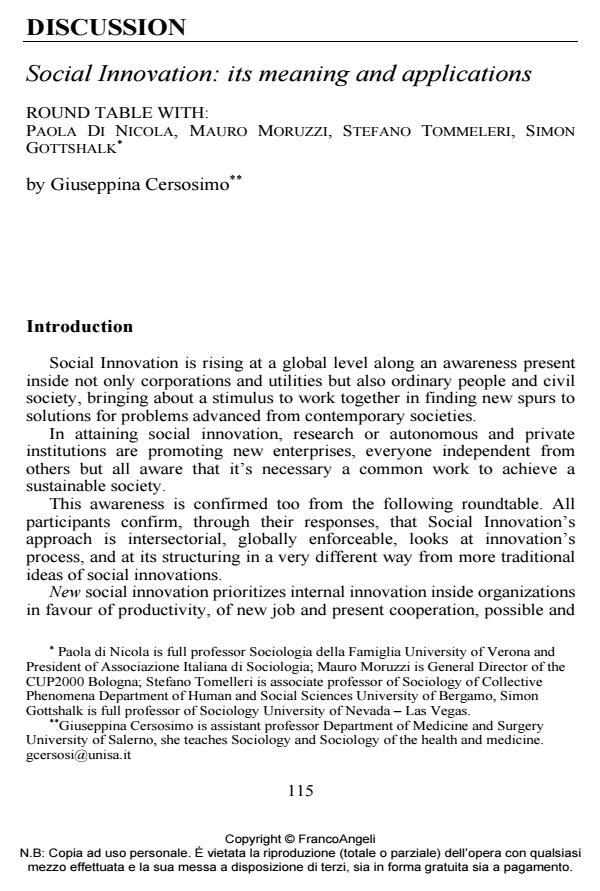Social Innovation: its meaning and applications. Round table with: Paola Di Nicola, Mauro Moruzzi, Stefano Tommeleri, Simon Gottshalk
Journal title SALUTE E SOCIETÀ
Author/s Giuseppina Cersosimo
Publishing Year 2015 Issue 2015/1EN Language English
Pages 14 P. 115-128 File size 80 KB
DOI 10.3280/SES2015-001009EN
DOI is like a bar code for intellectual property: to have more infomation
click here
Below, you can see the article first page
If you want to buy this article in PDF format, you can do it, following the instructions to buy download credits

FrancoAngeli is member of Publishers International Linking Association, Inc (PILA), a not-for-profit association which run the CrossRef service enabling links to and from online scholarly content.
From an analysis of the active citizenship’s practices introduced by Tuscany Region, this paper aims to examine the path of involvement for people with disabilities, their families and associations, in the elaboration of the Social Plan for Disability by the SdS North-West Florence. By choosing this case we aim to analyse the innovative and integrated use of the opportunities provided by the regional normative, which gave rise to a process of participation where the local community has been able to find shared answers to deal with some issues remained, for a long time, unresolved. The analysis shows how a conscious use of the possibilities provided by the institutional system may help to trigger collaborative and cooperative relationship among the different actors in the field (public institutions and private companies, third sector and citizens). However, during the analysis, the same institutional context (i.e. Tuscany Region) has taken shape as the main obstacle to the possibility that these paths may contribute to overcome the traditional approach to the health policy, which is sectorial and directive, in order to assign a leading role to the local community. .
Keywords: Participation, collaborative governance, social innovation, social care and health integration, community approach, consensus building
- Boudon R. (1984). La place du désordre: critique des théories du changement social. Presses Universitaires de France, 1984 (It. trans. 1985).
- Doni M., Tomelleri S. (2011). Giochi sociologici. Conflitto, cultura, immaginazione. Milano: Raffaello Cortina.
- Giaccardi C., Magatti M. (2014). Generativi di tutto il mondo unitevi. Milano: Feltrinelli.
- Gopnik A. (2011). The Information: How the Internet Gets Inside Us.The New Yorker, 87(1): 124–130. http://www.newyorker.com/magazine/2011/02/14/theinformation (Last accessed 09/09/2014).
- Guattari F. (1989). The Three Ecologies. New Formations, 8:134.
- Joss L.R. (2003). Managing with a Mission. Stanford Social Innovation Review, Center for Social Innovation.
- Martinelli M. (2011). L’altra libertà: saggio su Georg Simmel. Milano: Vita e Pensiero.
- Melucci A. (1996). Challenging codes. Collective action in the information age. Cambridge: Cambridge University Press.
- Mulgan G., Tucker S., Ali R., Sanders B. (2007). Social Innovation, What it is, Why it matters and how it can be accelerated. Skoll Centre for Social Entrepreneurship, Working Paper, Oxford Said Business School.
- Murray R., Grice J.C., Mulgan G. (2010). The Open Book of Social Innovation. The Young Fondation, Nesta.
- Nussbaum M. (2012). Creare capacità. Liberarsi dalla dittatura del PIL. Bologna: Il Mulino.
- Orlandini M. (2013). Co-produrre servizi di welfare: semantiche ed esempi per il contesto italiano. Sociologia e politiche sociali, 16(3): 111-134. DOI: 10.3280/SP2013-003005
- Phills J.A., Deiglmeier K., Miller D.T. (2008). Rediscovering Social Innovation. Stanford Social Innovation Review, 6(4), 34-44.
- Pizzo G., Tagliavini G., eds. (2013). Dizionario di microfinanza – Le voci del microcredito. Rome: Carrocci.
- Porter, Kramer M. (2011). Creating Shared Value: How to Reinvent Capitalism and Unleash a Wave of Innovation and Growth. Harvard Business Review
- Sen A. (2001). Sviluppo è libertà. Perché non c'è crescita senza democrazia. Milano: Mondadori.
- Tomelleri S., Artioli G., eds. (2013). Scoprire la collaborazione resiliente, Una ricerca-azione sulle relazioni interprofessionali in area sanitaria. Milano: FrancoAngeli.
- Woolf S.H. (2008). The Meaning of Translational Research and Why It Matters. JAMA 299(2): 3140–3148. DOI: 10.1001/jama.2007.26
Giuseppina Cersosimo, Social Innovation: its meaning and applications. Round table with: Paola Di Nicola, Mauro Moruzzi, Stefano Tommeleri, Simon Gottshalk in "SALUTE E SOCIETÀ" 1EN/2015, pp 115-128, DOI: 10.3280/SES2015-001009EN